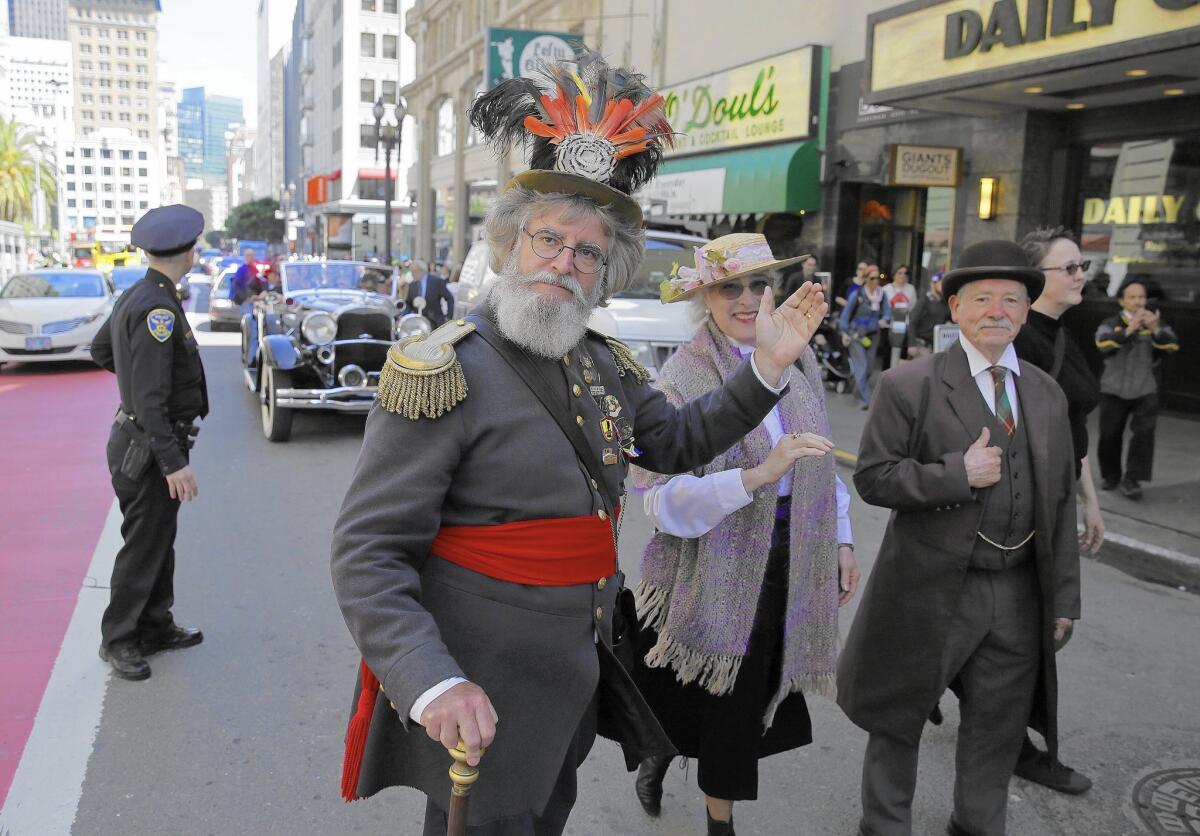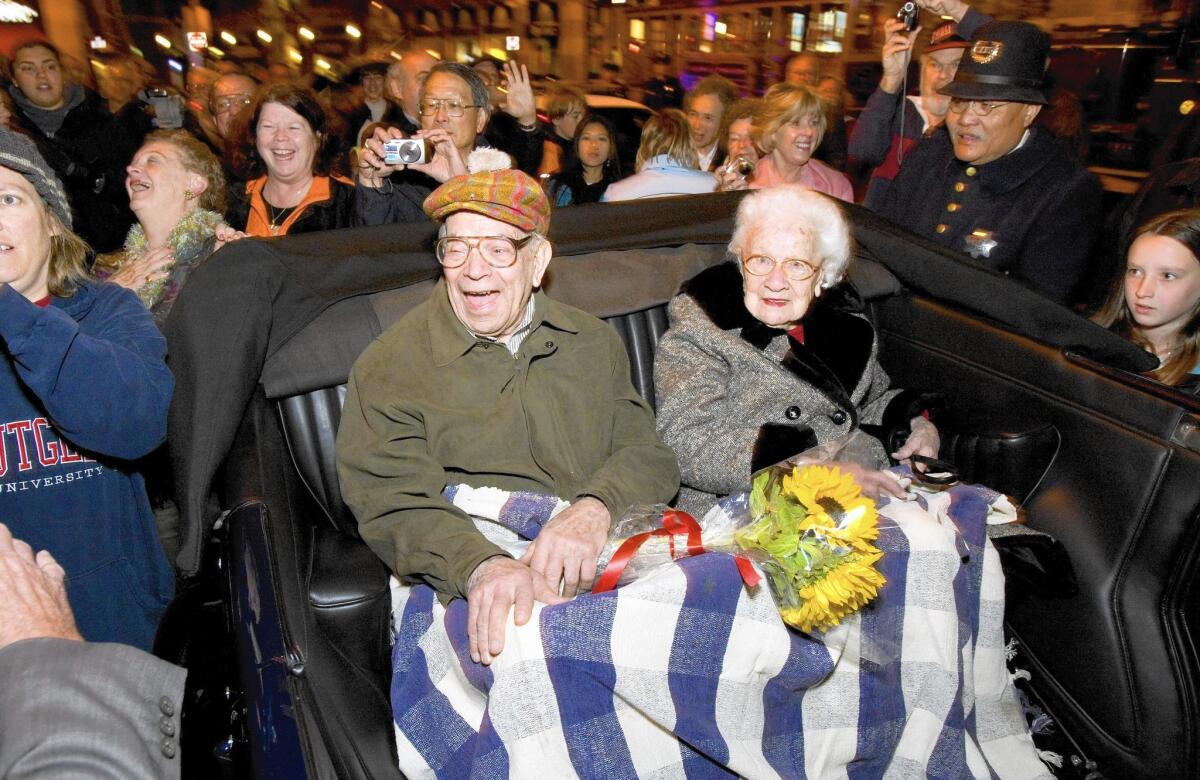With no more survivors on hand, San Francisco marks 110th anniversary of its great quake

- Share via
Reporting from San Francisco — It was a milestone that had to come.
The city early Monday marked the 110th anniversary of the great 1906 San Francisco earthquake — but did so without any of the hearty souls who survived the disaster.
The two last known survivors of the quake died over the last year, adding special poignancy to the occasion.
Last summer, Ruth Newman — the oldest remaining survivor — died at age 113.
Then, William Del Monte died in January, just shy of his 110th birthday. He last attended the memorial in 2011, reports at the time said.
In earlier years, many more survivors gamely ventured out in the middle of the night — every year on April 18 — to gather on a traffic island on Market Street. There, at 5:12 a.m., they would remember the deadliest earthquake in U.S. history, which opened up the San Andreas fault for an astonishing 300 miles and rocked much of this city into ruin.
Some became local celebrities, at least in the passionate world of San Francisco history buffs.
But even the old-timers started tuning out in recent years, as age took its toll; Del Monte attended via Skype in 2012. There were murmurs that, maybe, these remembrances should end once all the survivors were finally gone.
Yet on Monday, when it almost appeared that few would come except for city workers, reporters and a handful of costumed characters in 1906 attire, about 200 people suddenly arrived.
See the most-read stories this hour >>
They squeezed in around the 19th century cast-iron Lotta’s Fountain — which in 1906 was virtually the only thing left standing in a devastated downtown — to hear of a time when San Francisco sank into desperation, watching block by block fall to ash, and survivors fled on ferries to Oakland.
“To be honest with you, I didn’t anticipate too many people,” said Ron Ross, 79, president of the San Francisco History Assn. Still, he said, “they came out.”
And with that began a new focus — honoring the 3,000 who died in the famed earthquake and fire and warning today’s San Franciscans how close they could be to another devastating temblor if little progress is made on improving earthquake safety.
On hand was San Francisco’s chief resilience officer, Patrick Otellini, who told the crowd of new plans to house 95% of the city’s residents in San Francisco after the next big quake.

Part of that plan would mandate strengthening more types of earthquake-vulnerable buildings. Currently, wood apartments with five or more units need to be retrofitted; a report released Monday suggests requiring apartments with just three and four units also be strengthened. The plan also calls for the evaluation and retrofit of brittle buildings that could collapse in an earthquake.
Otellini also said the city was committed to strengthen the waterfront, which is in danger of suddenly lurching during a major temblor. At risk is the famed Embarcadero between Fisherman’s Wharf and AT&T Park, and the price tag is steep — $2 billion to $3 billion.
The focus on the future is important, said historian Joseph Amster, 60. “Instead of commemorating the survivors or hearing the stories of survivors, the overall theme now is about making sure we’re prepared for the next one.”
Without a significant earthquake here in a generation, it is easy to forget how the world can change when the San Andreas fault ruptures as it did in 1906, which was felt as far away as Oregon, Nevada and Los Angeles.
Back then, the magnitude 7.8 earthquake ruptured much of the length of the state, from Cape Mendocino to near San Juan Bautista. In San Francisco, the shaking lasted a full minute.
The first deaths came when low-rent tenements collapsed in the South of Market area, said Bob Sarlatte, who narrated. The fire chief was fatally injured when a hotel’s spire tower collapsed on his fire station home. Telephone and telegraph messages were cut.
Three hours after the first quake, a major aftershock brought down many of the damaged buildings that had been standing. Gas pipes ruptured, igniting fires, but so did water pipes. Workers at a temporary hospital at City Hall had to flee, and Union Square and Nob Hill were lost to the wind-whipped flames.
“It was the biggest urban fire in the history of the United States. It was 500 square blocks, over 28,000 buildings, over 2,600 acres burned. Seventy-five percent of inhabited San Francisco,” Amster said. “You can fit the Chicago fire, the Boston fire and the Baltimore fire — the three other biggest urban fires in the history of the country — within the burn area of the San Francisco fire.”
Monday’s ceremony still had the cast of costumed characters who are a mainstay of the remembrance. Amster wore a Civil War-era Union junior officer’s frock coat and a top hat with feathers, dressed as “Emperor Norton,” a failed San Francisco rice merchant who became a civic celebrity when he declared himself as emperor of the United States and protector of Mexico to the San Francisco Bulletin in 1859.
Also portrayed were Lillie Hitchcock Coit, whose fortune was later used to build Coit Tower; Domingo Ghirardelli, who started the eponymous chocolate company; Lotta Crabtree, the popular entertainer who secured the fountain that became so crucial after the 1906 earthquake; and the notorious Lola Montez, Crabtree’s mentor, famous for her spider dance. The fountain “was one of the only structures left intact in the downtown area after the fire, and loved ones would place notes on it,” Amster said.
Ross said it was a decade ago, on the quake’s 100th anniversary, when there was talk about shutting down the remembrance. But the answer was, “No, no, no, there’s too much interest.
“So we kept it going, even with the last survivor gone,” he said. “There’s a lot of new interest. The new generation is coming in.”
Twitter: @ronlin
ALSO
Lawmakers seek to tighten bullet train oversight, suggesting growing concern about the project
Moving the Rams from St. Louis to Southern California was no easy task
LAPD chief testifies in civil trial, denies he unfairly passed captain over for promotion
More to Read
Sign up for Essential California
The most important California stories and recommendations in your inbox every morning.
You may occasionally receive promotional content from the Los Angeles Times.











